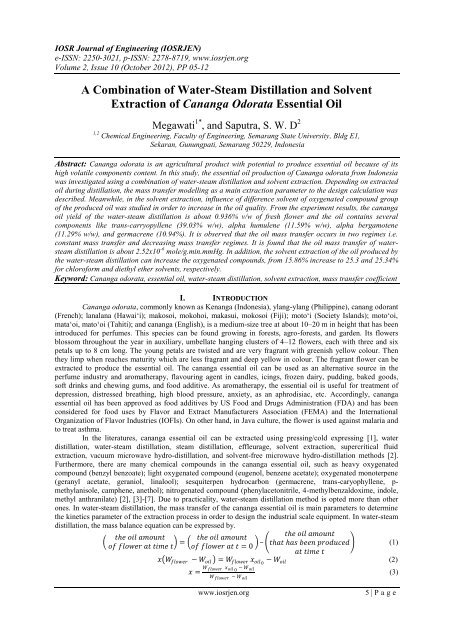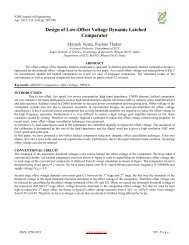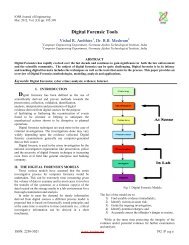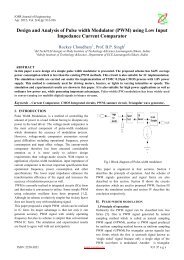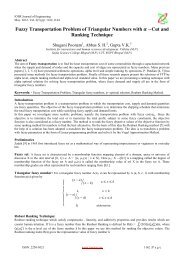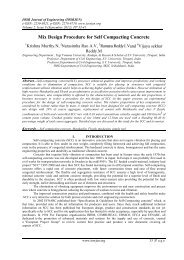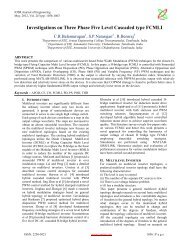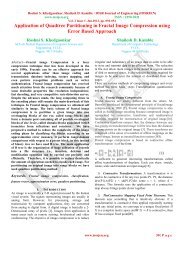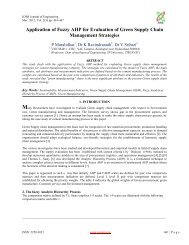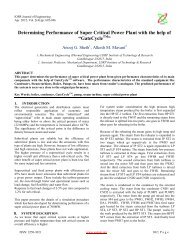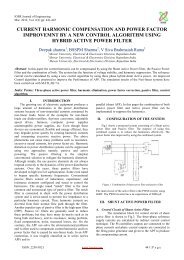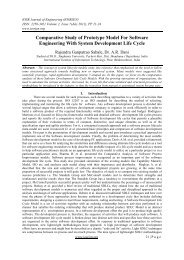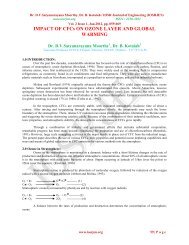A Combination Of Water-Steam Distillation And Solvent - IOSRJEN
A Combination Of Water-Steam Distillation And Solvent - IOSRJEN
A Combination Of Water-Steam Distillation And Solvent - IOSRJEN
Create successful ePaper yourself
Turn your PDF publications into a flip-book with our unique Google optimized e-Paper software.
IOSR Journal of Engineering (<strong>IOSRJEN</strong>)<br />
e-ISSN: 2250-3021, p-ISSN: 2278-8719, www.iosrjen.org<br />
Volume 2, Issue 10 (October 2012), PP 05-12<br />
A <strong>Combination</strong> of <strong>Water</strong>-<strong>Steam</strong> <strong>Distillation</strong> and <strong>Solvent</strong><br />
Extraction of Cananga Odorata Essential Oil<br />
Megawati 1* , and Saputra, S. W. D 2<br />
1,2 Chemical Engineering, Faculty of Engineering, Semarang State University, Bldg E1,<br />
Sekaran, Gunungpati, Semarang 50229, Indonesia<br />
Abstract: Cananga odorata is an agricultural product with potential to produce essential oil because of its<br />
high volatile components content. In this study, the essential oil production of Cananga odorata from Indonesia<br />
was investigated using a combination of water-steam distillation and solvent extraction. Depending on extracted<br />
oil during distillation, the mass transfer modelling as a main extraction parameter to the design calculation was<br />
described. Meanwhile, in the solvent extraction, influence of difference solvent of oxygenated compound group<br />
of the produced oil was studied in order to increase in the oil quality. From the experiment results, the cananga<br />
oil yield of the water-steam distillation is about 0.936% v/w of fresh flower and the oil contains several<br />
components like trans-carryopyllene (39.03% w/w), alpha humulene (11.59% w/w), alpha bergamotene<br />
(11.29% w/w), and germacrene (10.94%). It is observed that the oil mass transfer occurs in two regimes i.e.<br />
constant mass transfer and decreasing mass transfer regimes. It is found that the oil mass transfer of watersteam<br />
distillation is about 2.52x10 -6 mole/g.min.mmHg. In addition, the solvent extraction of the oil produced by<br />
the water-steam distillation can increase the oxygenated compounds, from 15.86% increase to 25.3 and 25.34%<br />
for chloroform and diethyl ether solvents, respectively.<br />
Keyword: Cananga odorata, essential oil, water-steam distillation, solvent extraction, mass transfer coefficient<br />
I. INTRODUCTION<br />
Cananga odorata, commonly known as Kenanga (Indonesia), ylang-ylang (Philippine), canang odorant<br />
(French); lanalana (Hawai„i); makosoi, mokohoi, makasui, mokosoi (Fiji); moto„i (Society Islands); moto„oi,<br />
mata„oi, mato„oi (Tahiti); and cananga (English), is a medium-size tree at about 10–20 m in height that has been<br />
introduced for perfumes. This species can be found growing in forests, agro-forests, and garden. Its flowers<br />
blossom throughout the year in auxiliary, umbellate hanging clusters of 4–12 flowers, each with three and six<br />
petals up to 8 cm long. The young petals are twisted and are very fragrant with greenish yellow colour. Then<br />
they limp when reaches maturity which are less fragrant and deep yellow in colour. The fragrant flower can be<br />
extracted to produce the essential oil. The cananga essential oil can be used as an alternative source in the<br />
perfume industry and aromatherapy, flavouring agent in candles, icings, frozen dairy, pudding, baked goods,<br />
soft drinks and chewing gums, and food additive. As aromatherapy, the essential oil is useful for treatment of<br />
depression, distressed breathing, high blood pressure, anxiety, as an aphrodisiac, etc. Accordingly, cananga<br />
essential oil has been approved as food additives by US Food and Drugs Administration (FDA) and has been<br />
considered for food uses by Flavor and Extract Manufacturers Association (FEMA) and the International<br />
Organization of Flavor Industries (IOFIs). On other hand, in Java culture, the flower is used against malaria and<br />
to treat asthma.<br />
In the literatures, cananga essential oil can be extracted using pressing/cold expressing [1], water<br />
distillation, water-steam distillation, steam distillation, effleurage, solvent extraction, supercritical fluid<br />
extraction, vacuum microwave hydro-distillation, and solvent-free microwave hydro-distillation methods [2].<br />
Furthermore, there are many chemical compounds in the cananga essential oil, such as heavy oxygenated<br />
compound (benzyl benzoate); light oxygenated compound (eugenol, benzene acetate); oxygenated monoterpene<br />
(geranyl acetate, geraniol, linalool); sesquiterpen hydrocarbon (germacrene, trans-caryophyllene, p-<br />
methylanisole, camphene, anethol); nitrogenated compound (phenylacetonitrile, 4-methylbenzaldoxime, indole,<br />
methyl anthranilate) [2], [3]-[7]. Due to practicality, water-steam distillation method is opted more than other<br />
ones. In water-steam distillation, the mass transfer of the cananga essential oil is main parameters to determine<br />
the kinetics parameter of the extraction process in order to design the industrial scale equipment. In water-steam<br />
distillation, the mass balance equation can be expressed by.<br />
the oil amount<br />
of flower at time t<br />
=<br />
the oil amount<br />
of flower at t = 0<br />
–<br />
the oil amount<br />
that has been produced<br />
at time t<br />
x W flower − W oil = W flower x oil 0<br />
− W oil (2)<br />
x = W flower x oil 0 − W oil<br />
W flower − W oil<br />
(3)<br />
(1)<br />
www.iosrjen.org<br />
5 | P a g e
A combination of water-steam distillation and solvent extraction of Cananga odorata essential oil<br />
where: x is the essential oil content in flower during extraction.<br />
In addition, the mass transfer of essential oil from flower surface occurs in two regimes i.e. constant<br />
mass transfer and decreasing mass transfer regimes. The mass transfer of essential oil is assumed constant when<br />
the essential oil yield does not yet reach a critical point. The essential oil yield in this step is higher than the<br />
critical yield and the mass transfer area in the flower surface is still constant. Whereas, when the essential oil<br />
content reached the critical yield, so the mass transfer of essential oil starts to decrease. A lot of researches that<br />
studied the mass transfer and kinetics of essential oil distillation as an important research component, such as a<br />
steam distillation for Pimpinella anisum essential oil [8], a steam distillation for Cymbopogon winterianus<br />
essential oil [9], a hydro/steam distillation for Ylang-ylang oil [10], and a steam distillation for Ocimum<br />
Basillicum [11]. In addition, the results of this model can be compared with the other models.<br />
While, the extracted cananga essential oil by distillation method can produce not only volatile<br />
compound (essential oils) but also non-volatile compound (resin, wax, pigment, gums, fatty acids and other<br />
anhydrous oils) [2], [5]. Consequently, it is potential to purify of the cananga essential oil in order to increase<br />
the volatile compounds, especially the oxygenated compound group as the odoriferous components. The solvent<br />
extraction is one of chemically methods expect distillation and adsorption that can be applied to separate the<br />
impurities of cananga essential oil [2]. The distillation method to purify the essential oil produced by distillation<br />
must be operated at high pressure due to the boiling point of the essential oil components is high. However, the<br />
adsorption method must be conducted in very complex procedures in order to achieve the high efficiency of<br />
molecular sieve of the various oil components. Interestingly, in the present study, the essential oil purification<br />
that be conducted is solvent extraction method. In addition, the chosen solvent solutions are chloroform (a nonpolar<br />
organic solvent) and diethyl ether (a non-polar organic solvent that slightly polar). This chosen has a<br />
prediction that the essential oils are complex mixtures of a great number of different components that can be<br />
divided in the functional groups like acid, alcohol, ketone, aldehyde, esther, ether, and alkane. These functional<br />
groups have different polarity that can be written from the most to less of the polar rank as follows: acid ><br />
alcohol > ketone > aldehyde > esther > ether > alkane. Thus, the influence of solvent polarity of solvent<br />
extraction can be studied. For that previously reasons, the aims of this research are to model and find the mass<br />
transfer coefficient of the Cananga odorata essential oil extraction using water-steam distillation and to study<br />
the influence of organic solvent solution of the solvent extraction in order to increase the volatile components of<br />
the essential oil.<br />
Experiment <strong>And</strong> Method<br />
II.<br />
A. The theoretically essential oil content analysis of Cananga odorata essential oil<br />
The Cananga odorata flower was sliced and weighted at 5 g, and then it was extracted via soxchlet<br />
aparatus with n-hexane solvent at temperature of 70 - 80 o C until 20 of cycles. The attained cananga oil was<br />
distillated to evaporate the solvent at temperature of 70 o C until the oil solution volume of about 5 mL. After<br />
that, the essential oil was dried in oven to evaporate the residual solvent. The theoretically essential oil yield is a<br />
ratio number between essential oil with fresh flower weight.<br />
B. The water-steam distillation of Cananga odorata essential oil<br />
300 g Cananga odorata flower is extracted in 7 L pressure vessel operated at pressure of 1.5 atm (Fig.<br />
1). The pressure vessel is equipped with a condenser, pressure gauge (in the range of 0-10 atm), ¼” pressure<br />
relieved valve, safety valve, basket, and glass level indicator. The condensed vapour flow through in 50 mL<br />
beuret in order to measure the volume of the essential oil and water every time interval of 30 min. During the<br />
process, the pressure distillation is kept constant at 1.5 bar. The pressure distillation was operated above the<br />
atmospheric condition in order to increase the extraction temperature, so that the essential oil yield can be<br />
increased. The extraction was stopped after the distillation time reach 8 hours. The essential oil density<br />
measurement was conducted using a liquid pycnometer. <strong>And</strong> then, the essential oil constituents were analysed<br />
by a Hewlett Packard HP5890 series II plus gas chromatograph equipped with a HPMS 5989b mass<br />
spectrometer using electron impact. The mass spectrometry (MS) conditions were as follows: ionization voltage,<br />
70eV; emission current, 40 mA; scan rate, 1 scan/s; mass range, 35–300 Da; ion source temperature, 200 o C.<br />
The MS fragmentation pattern was checked with those of other essential oils of known composition, with pure<br />
compounds and by matching the MS fragmentation patterns with WILEY229 mass spectra libraries and with<br />
those in the literature. The relative amounts of the individual components were obtained from GC analysis based<br />
on peak areas using the generalized equation of Van den Dool and Kratz [12].<br />
www.iosrjen.org<br />
6 | P a g e
A combination of water-steam distillation and solvent extraction of Cananga odorata essential oil<br />
FI<br />
PI<br />
PC<br />
C<br />
5<br />
T<br />
I<br />
4<br />
2<br />
6<br />
1<br />
3<br />
Fig. 1. Equipment schema of water-steam distillation (1: water area, 2: simplisia area, 3: heater, 4: condenser,<br />
5: vapour valve, 6: beuret)<br />
C. The solvent extraction of Cananga Odorata essential oil<br />
Initially, the mixture of 50 mL of cananga essential oil and 50 mL of solvent and 1% w/v of sodium<br />
chloride was placed in the three neck extraction flask equipped with a magnetic stirrer and condenser to prevent<br />
the solvent to come out due to the solution high volatility. Sodium chloride was added to facilitate the emulsion<br />
breakdown. The extraction is stopped when the reaction time has reached 1 hour. The variable of the research is<br />
extraction solvent i.e. chloroform (SIGMA 3045) and diethyl ether (SIGMA 3098). Before the solvent was<br />
evaporated to its recovery from the mixture with essential oil, sodium sulphate was added to remove the organic<br />
phase followed by filtration. The evaporation was conducted under a vacuum in a rotary-evaporator (SIGM<br />
1209) at temperature of 30 o C for 4 hours. The produced cananga essential oil was stored in dark bottles at 4 o C<br />
prior to composition analysis using GC-MS method.<br />
III. RESULT AND DISCUSSION<br />
From the experiment of essential oil content using a standard procedure [1], the theoretically essential<br />
oil yield is about 1.159 and 1.324% w/w of the fresh flower for experiments 1 and 2, respectively. From the<br />
water-steam distillation, the obtained essential oil yield was about 0.936% w/w of the fresh flower and the<br />
density of one was about 0.9026 g/mL. It is obvious that water-steam distillation at pressure of 1.5 bar is an<br />
efficient process that can extract the Cananga essential oil with the theoretically yield of about 71 to 81%. The<br />
oil and water volumes in distillate can be seen in Table 1 and the oil mole at various times is plotted in Fig. 2.<br />
The numbers of mole and mass were then calculated by the assumption of the water density = 1 g/mL (pure<br />
water), the water molecular weight = 18 g/mole, the oil density = 0.9026 g/mL (constant during the process),<br />
and the oil molecular weight = 164 g/mole. The calculation results of mole and mass of the oil and water in<br />
distillate are listed in Table 1.<br />
Table 1: <strong>Water</strong> and oil in the distillate<br />
time water essential oil time water Essential oil<br />
(min) mL g mole mL G mole (min) mL g mole mL g Mole<br />
0 0 0 0 0 0 0 165 1017 1017 165 1.80 1.6247 0.0099<br />
15 42 42 15 0 0 0 180 1197 1197 180 1.90 1.7149 0.0105<br />
30 72 72 30 0.30 0.2708 0.0017 195 1392 1392 195 1.95 1.7601 0.0107<br />
45 117 117 45 0.40 0.3610 0.0022 210 1602 1602 210 2.00 1.8052 0.0110<br />
60 177 177 60 0.50 0.4513 0.0028 225 1827 1827 225 2.05 1.8503 0.0113<br />
75 252 252 75 0.70 0.6318 0.0039 240 2067 2067 240 2.10 1.8955 0.0116<br />
90 342 342 90 0.90 0.8123 0.0050 255 2322 2322 255 2.15 1.9406 0.0118<br />
105 447 447 105 1.10 0.9929 0.0061 270 2592 2592 270 2.20 1.9857 0.0121<br />
120 567 567 120 1.30 1.1734 0.0072 285 2877 2877 285 2.25 2.0309 0.0124<br />
135 702 702 135 1.50 1.3539 0.0083 300 3177 3177 300 2.30 2.0760 0.0127<br />
150 852 852 150 1.70 1.5344 0.0094<br />
165 1017 1017 165 1.80 1.6247 0.0099<br />
www.iosrjen.org<br />
7 | P a g e
oil in distillate, mole<br />
oil in flower, mole<br />
A combination of water-steam distillation and solvent extraction of Cananga odorata essential oil<br />
0.016<br />
0.014<br />
0.012<br />
0.01<br />
0.008<br />
0.006<br />
0.004<br />
0.002<br />
0<br />
oil in distillate<br />
oil in flower<br />
0 75 150 225 300<br />
time, minute<br />
Fig. 2. Essential oil in distillate and flower<br />
0.016<br />
0.014<br />
0.012<br />
0.01<br />
0.008<br />
0.006<br />
0.004<br />
In Fig. 2, it is obvious that the correlation of the oil fraction mole between times has two phenomena.<br />
The first phenomenon is increasing of the oil mole during distillation from 0–105 minutes can be expressed by a<br />
linear curve. <strong>And</strong> the second is increasing of the oil mole starts to decrease (above 105 minutes). Accordingly,<br />
the point that increasing of oil mole starts to decrease is as a critical point of the extraction [13], [14]. The<br />
phenomena are caused by the mass transfer of essential oil from flower surface in water-steam distillation which<br />
occurs in two steps as follows.<br />
The mass transfer of essential oil is constant<br />
The process assumption can be applied until when the essential oil content reach a critical point. The<br />
essential oil yield in this step is higher than the critical yield and the mass transfer area in the flower surface is<br />
still constant. The essential oil yield in the flower can be calculated by Equation (3). The calculation results can<br />
be seen in Table 2 and Fig. 2.<br />
Table 2: Essential oil fraction in flower<br />
time<br />
(min)<br />
oil fraction in flower<br />
(x)<br />
Time<br />
(min)<br />
oil fraction in flower<br />
(x)<br />
time<br />
(min)<br />
oil fraction in flower<br />
(x)<br />
0 0.013240 120 0.009365 225 0.007116<br />
15 0.013240 135 0.008767 240 0.006966<br />
30 0.012349 150 0.008167 255 0.006815<br />
45 0.012051 165 0.007867 270 0.006665<br />
60 0.011753 180 0.007567 285 0.006515<br />
75 0.011157 195 0.007417 300 0.006364<br />
90 0.010561 210 0.007266 315 0.006364<br />
105 0.009963<br />
From Table 2, the critical yield of the oil extraction attained at the time of 105 minutes and the<br />
essential oil yield in the distillate of 0.00939. This step occurs fast, consequently water and vapour are<br />
equilibrium and immiscible, so that the relation equations of pressure and water vapour fraction can be written<br />
as follows:<br />
y water<br />
= P o<br />
water<br />
P<br />
However, a relation equation of pressure and essential oil vapour fraction is as in Equation 5.<br />
y oil = P oil<br />
(5)<br />
P<br />
At the vapour phase, the water and essential oil fraction relation is<br />
y water + y oil = 1 (6)<br />
Therefore the essential oil vapour fraction can be expressed into mole fraction in form<br />
y oil =<br />
Rearranging above equations gives Equation (8).<br />
o<br />
m oil<br />
m oil + m water<br />
(7)<br />
(4)<br />
www.iosrjen.org<br />
8 | P a g e
oil mole in distillate, mole<br />
A combination of water-steam distillation and solvent extraction of Cananga odorata essential oil<br />
m oil =<br />
y oil<br />
m<br />
1 − y water (8)<br />
oil<br />
Equation (8) show that the relation between essential oil mole with water mole in distillate in step 1 is a<br />
linear curve with slope of y oil /(1-y oil ). From the experiment data we can make a plot of oil mole (m oil ) versus<br />
water mole (m water ), so that the value of essential oil fraction in vapour can be calculated. Consequently, with<br />
Equation (6) we can evaluate the essential oil pure vapour pressure. The results of the curve linear regression of<br />
oil mole versus water mole of the Cananga odorata essential oil distillation when the process time duration is<br />
105 minutes can be seen in Fig 3. The slope obtained is about 2.6x10 -6 , so that the oil fraction and pure pressure<br />
in the vapour (y oil ) are about 0.00026 and 0.152 mmHg, respectively.<br />
0.008<br />
0.006<br />
0.004<br />
y = 2.60E-04x<br />
0.002<br />
0<br />
0 5 10 15 20 25<br />
water mole in distillate, mole<br />
Fig. 3 Linear regression result between oil mole versus water mole in distillate<br />
The mass transfer of essential oil decreases<br />
The process can be applied if essential oil content reaches the critical yield and continue to decrease. In<br />
this step, the essential oil yield as well as the mass transfer area in the flower surface decrease. The mass<br />
transfer rate between phases from liquid phase to vapour phase can be arranged by Equation (9) and can be<br />
numerically solved by forming of Equation (10).<br />
If<br />
∆m oil<br />
∆t<br />
m flower . P<br />
o ∆m<br />
oil −<br />
oil<br />
∆m oil +∆m water<br />
.P T<br />
β. K y a =<br />
β. K y a =<br />
dm oil<br />
dt<br />
m flower . P<br />
o dm<br />
oil − oil .P<br />
dm oil +dm T<br />
water<br />
∆m oil<br />
∆t<br />
m flower . Po ∆m<br />
m −<br />
oil<br />
.P<br />
∆m oil +∆m T<br />
water<br />
= Z, so equation (10) becomes:<br />
Z = β. K y a (11)<br />
The value of β can be assumed by Equation (12) and then substituted in Equation (11). The result is Equation<br />
(13).<br />
β = e −α(x−x c)<br />
(12)<br />
Z = e −α(x−x c ) . K y a (13)<br />
Equation (13) can be solved by the logarithm procedure as follows:<br />
ln Z = −α. x − x c + ln(K y a) (14)<br />
Parameters α and K y a can be found by linear regression of −(x − x c ) versus ln (Z) which the values<br />
of and K y a are values of slope and intercept of the line. Finally, from the data of oil and water moles in<br />
distillate, the mass transfer coefficient of Cananga odorata essential oil of water-steam distillation is about 2.52<br />
x 10 -6 mole/g.min.mmHg.<br />
The GC-MS analysis results of the Cananga odorata essential oil<br />
The GC-MS analysis results of the Cananga odorata essential oil extracted by water-steam distillation<br />
and solvent extraction can be seen in Fig. 4 and Tables 3. The composition can be accordingly divided by the<br />
oxygenated compound as in Table 4.<br />
In Fig. 4 and Table 3, It can be seen that the main composition of Cananga odorata essential oil<br />
produced by water-steam distillation were trans-carryopyllene (39.03% w/w) followed alpha humulene (11.59%<br />
w/w), alpha bergamotene (11.29% w/w), and germacrene (10.94%). However, after the essential oil extracted by<br />
chloroform, the main composition were trans carryopyllene (26.10% w/w) followed by germacrene (12.04%),<br />
www.iosrjen.org<br />
9 | P a g e<br />
(9)<br />
(10)
A combination of water-steam distillation and solvent extraction of Cananga odorata essential oil<br />
and alpha humulene (10.79% w/w). After the essential oil extracted by diethyl ether, the main compositions<br />
were trans carryopyllene (25.01% w/w) followed germacrene (10.31%), and alpha humulene (10.86% w/w). At<br />
the crude oil, oil extracted by chloroform, and oil extracted by diethyl ether, the compound group of the<br />
essential oils were mainly the same. The most abundant group is sesquiterpen. Other compound groups with<br />
high amount are oxygenated monoterpen, high oxygenated, and heavy oxygenated compounds. The oxygenated<br />
compound is highly odoriferous, while the sesquiterpene hydrocarbon contributes only little to fragrance<br />
produced. The quality of cananga oil increases with the content of oxygenated compounds which is the result of<br />
this purification with the solvent extraction by chloroform. The oil extracted by chloroform and diethylether<br />
contain much more oxygenated compound than the crude oil (25.3 and 25.34% versus 15.86%). On the other<br />
hand, the sesquiterpen hydrocarbon is present in a higher quantity in the crude oil than the oil extracted by<br />
chloroform and diethylether (84.13% versus 76.09 and 75.33%). Therefore the purification of Cananga odorata<br />
oil by solvent extraction using chloroform yields better than the crude oil produced by water-steam distillation.<br />
A<br />
B<br />
C<br />
Fig. 4 Gas chromatography of A: Cananga odorata oil crude; B: Cananga odorata oil extracted by chloroform;<br />
C: Cananga odorata oil extracted by diethyl ether<br />
www.iosrjen.org<br />
10 | P a g e
A combination of water-steam distillation and solvent extraction of Cananga odorata essential oil<br />
Table 3. Chemical composition (mass %) of Cananga odorata crude oil; Cananga odorata oil extracted by<br />
chloroform; and Cananga odorata oil extracted by diethyl ether<br />
No Composition Type Crude oil Oil extracted<br />
by chloroform<br />
Oil extracted<br />
by diethyl ether<br />
1 Anisole S 1.42 2.38 2.1<br />
2 Linalool OM 6.37 7.36 6.76<br />
3 Geraniol OM 0.51 1.56 1.46<br />
4 alpha Copaene S 2.31 1.71 2.07<br />
5 Geranyl acetate OM 0.49 0.36 1.06<br />
6 trans-Carryopyllene S 39.03 26.1 25.01<br />
7 Germacrene S 10.94 12.04 10.31<br />
8 alpha-Humulene S 11.59 10.79 10.83<br />
9 alpha Bergamotene S 11.29 - -<br />
10 delta-Cadinene S 5.44 5.36 7.64<br />
11 Naphthalene S 0.13 3.4<br />
12 Carryophylene oxide S* 1.19 1.29 1.21<br />
13 Humulene oxide S* 0.2 - 0.65<br />
14 Globulol OM 0.93 2.29 2.42<br />
15 alpha Longipinene S 0.16 6.76 6.91<br />
16 Torreyol S 1.82 2.95 2.84<br />
17 alpha Cadinol OM 2.05 3.21 3.39<br />
18 Farnesol OM 0.69 1.78 1.98<br />
19 Benzyl benzoate HOC 2.98 1.75 4.14<br />
20 Farnesyl acetate OM 0.45 0.11 0.63<br />
21 Eugenol LOC - 1.41 0.68<br />
22 beta Elemene S - 0.65 0.63<br />
23 alpha Farnesene S - 6.19 6.76<br />
24 Cububene S - 0.26 0.23<br />
25 Nerolidol OM - 0.28 0.28<br />
S = sesquiterpen hydrocarbon<br />
S* = oxygenated sesquiterpen<br />
OM = oxygenated monoterpen<br />
LOC = light oxygenated compound<br />
HOC = heavy oxygenated compound<br />
Table 4. Compound group of essential oil<br />
Compound Crude oil Oil extracted by<br />
chloroform<br />
Oil extracted by<br />
ether<br />
S 84.13 76.09 75.33<br />
S* 1.39 1.49 1.86<br />
OM 11.49 16.95 17.98<br />
LOC 0 2.82 1.36<br />
HOC 2.98 4.04 4.14<br />
IV. CONCLUSIONS<br />
The Cananga odorata oil can be produced by a combination of water-steam distillation and solvent<br />
extraction using chloroform and diethylether. The mass transfer of the essential oil of water-steam distillation is<br />
about 2.52x10 -6 mole/g.min.mmHg and the pure vapor pressure is about 0.152 mmHg. The main compound of<br />
the essential oil produced by water-steam are trans-carryopyllene (39.03% w/w), alpha humulene (11.59% w/w),<br />
alpha bergamotene (11.29% w/w), and germacrene (10.94%). The solvent extraction of the essential oil using<br />
chloroform and diethylether can be increase the oxygenated compounds, from 15.86% increase to 25.3 and<br />
25.34% for solvent of chloroform and diethyl ether, respectively. On the other hand, the sesquiterpen compound<br />
can decrease due to purification using solvent extraction by chloroform and diethyl ether, from 84.13% decrease<br />
to 76.09 and 75.33%, respectively. Therefore the solvent extraction by chloroform and diethylether of the<br />
cananga essential oil produced by water-steam distillation can increase the oxygenated compound group.<br />
www.iosrjen.org<br />
11 | P a g e
A combination of water-steam distillation and solvent extraction of Cananga odorata essential oil<br />
Acknowledgment<br />
The research is funded by Regular Research Program of Faculty of Engineering, Semarang State<br />
University – Indonesia.<br />
REFERENCES<br />
[1]. G. G. Guenther, The essential oil, 2nd ed., New York, USA: D. Van Nostrand Company Inc., 1948.<br />
[2]. M. Kristiawan, V. Sobolik, and K. Allaf, “Isolation of Indonesia Cananga oil using multi-cycle pressure drop<br />
process”, Journal of Chromatography A, vol. 1192, pp. 306-318, 2008.<br />
[3]. U. Muchjajib, and S. Muchjajib, “Effect of Picking Time on Essential Oil Yield of Ylang-ylang (Cananga odorata)”,<br />
in ISHS Acta Horticulturae 925: XXVIII International Horticultural Congress on Science and Horticulture for<br />
People (IHC2010): A New Look at Medicinal and Aromatic Plants Seminar, 2010.<br />
[4]. W. Wongkaew, and K. Chiangthong “The Influence of Stages of Floral Development on Essential Oil Composition<br />
in Cananga odorata (Lam.) Hook.f. & Thomson var. fruticosa (Craib) J. Sinclair*”, The Journal of the Royal<br />
Institute of Thailand, vol. 30, no. 2, Apr.-Jun. 2005.<br />
[5]. E. E. Stashenko, W. Torres, J. R. M. Morales, “A study of the compositional variation of the essential oil of ylangylang<br />
(Cananga odorata Hook Fil. et Thomson, formagenuina) during flower development,” Journal of High<br />
Resolution Chromatography, vol. 18, Issue 2, pp. 101–104, February 1995.<br />
[6]. E. Stashenko, J. R. Martinez, C. MacKu, T. Shibamoto, “HRGC and GC–MS analysis of essential oil from<br />
colombian ylang-ylang (Cananga odorata Hook fil. et Thomson, forma genuina)”, Journal of High Resolution<br />
Chromatography, vol. 16, Issue 7, pp. 441–444, July 1993.<br />
[7]. A. F. Lindain, R. A. Reglos, C. C. de Guzman, and Ma. L. O. Cedo, “Tissue Culture and Essential Oil Production<br />
From Callus Cultures of Ilang-Ilang [Cananga odorata (Lamk) Hook.f. & Thomson]”, The Philippine Agricultural<br />
Scientist, vol. 91, no. 3, pp. 251-260, September 2008.<br />
[8]. M. Romdhane and C. Tizaoui, “The kinetic modelling of a steam distillation unit for the extraction of aniseed<br />
(Pimpinella anisum) essential oil”, J Chem Technol Biotechnol, vol. 80, pp. 759–766.<br />
[9]. E. Cassel and R. M. F. Vargas, “Experiments and Modeling of the Cymbopogon winterianus Essential Oil<br />
Extraction by <strong>Steam</strong> <strong>Distillation</strong>”, J. Mex. Chem. Soc., vol. 50(3), pp. 126-129, 2006.<br />
[10]. A. Mindaryani and S. S. Rahayu, “Essential Oil from Extraction and <strong>Steam</strong> <strong>Distillation</strong> of Ocimum Basillicum”, in<br />
Proceedings of the World Congress on Engineering and Computer Science (WCECS2007), October 24-26, 2007,<br />
San Francisco, USA.<br />
[11]. H. Van den Dool and P. D. Kratz, “A generalization of the retention index system including linear temperature<br />
programmed gas liquid partition chromatography. J. Chromatogr. 11: 463–71 (1963).<br />
[12]. G. G., Brown, A. S. Foust, and D. Katzs, “ Unit Operation”, 14nd edition, New York, USA, John Wiley and Sons<br />
Inc., 1950.<br />
[13]. R. E., Treybal, “Mass Transfer Operation”, 3nd edition, Tokyo, Japan, McGraw-Hill International Book Co., 1981.<br />
www.iosrjen.org<br />
12 | P a g e


